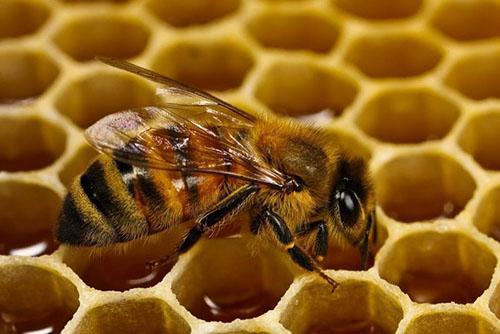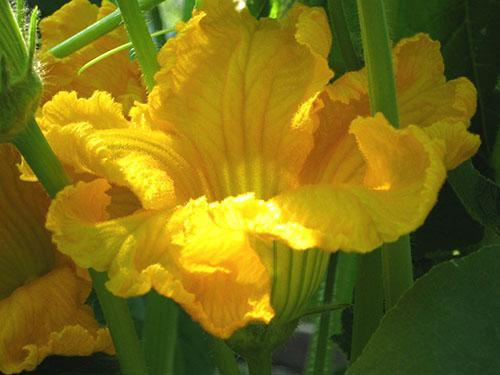Let's find out about the medicinal properties of pumpkin honey
 Among the products of the plant world, honey has a special place. The pollen collected by the bees is processed and put into combs to feed the offspring. Before that, it undergoes processing with the glands of a worker bee, the healing product preserves the beneficial substances of pollen and multiplies them. The medicinal properties of pumpkin honey have been confirmed for centuries. The product is unique in its composition, but the payoff of bees is small. Therefore, real honey is often replaced with homemade honey. Read about the benefits of pumpkin seeds for the human body!
Among the products of the plant world, honey has a special place. The pollen collected by the bees is processed and put into combs to feed the offspring. Before that, it undergoes processing with the glands of a worker bee, the healing product preserves the beneficial substances of pollen and multiplies them. The medicinal properties of pumpkin honey have been confirmed for centuries. The product is unique in its composition, but the payoff of bees is small. Therefore, real honey is often replaced with homemade honey. Read about the benefits of pumpkin seeds for the human body!
How is pumpkin honey obtained?

 So true pumpkin honey can only be obtained with a special order to the beekeeper and subject to the availability of large pumpkin plantations in the area. Only pumpkin honey has a bright yellow color, not very sweet, without bitterness and with a melon aftertaste. Honey has a special composition, it contains delicate substances that are not present in other products.
So true pumpkin honey can only be obtained with a special order to the beekeeper and subject to the availability of large pumpkin plantations in the area. Only pumpkin honey has a bright yellow color, not very sweet, without bitterness and with a melon aftertaste. Honey has a special composition, it contains delicate substances that are not present in other products.
They learned how to get healing honey in the Republic of Bashkortostan. It is there, on the endless melons with pumpkins, that hives are taken out during the flowering of pumpkins and natural honey is obtained.
 However, people have learned to get pumpkin honey without the participation of bees. It has a less concentrated, slightly modified composition, but the healing properties of pumpkin honey obtained on their own are confirmed by practice.
However, people have learned to get pumpkin honey without the participation of bees. It has a less concentrated, slightly modified composition, but the healing properties of pumpkin honey obtained on their own are confirmed by practice.
 To obtain honey, a small pumpkin is opened from the stalk, creating a cork. Seeds are selected through the hole, the cavity is filled with granulated sugar or any honey, closed with a removed cork and placed in a warm place for 10 days. The resulting honey is stored in the refrigerator, and the rind soaked in nectar can be used to make candied fruits.
To obtain honey, a small pumpkin is opened from the stalk, creating a cork. Seeds are selected through the hole, the cavity is filled with granulated sugar or any honey, closed with a removed cork and placed in a warm place for 10 days. The resulting honey is stored in the refrigerator, and the rind soaked in nectar can be used to make candied fruits.
Pumpkin honey - benefits and harms
 All the beneficial substances contained in the pulp of the pumpkin pass into a dissolved state and are fermented in heat for 10 days. Their composition is represented by a vitamin group:
All the beneficial substances contained in the pulp of the pumpkin pass into a dissolved state and are fermented in heat for 10 days. Their composition is represented by a vitamin group:
- ascorbic acid or vitamin C;
- a nicotinic acid;
- group B;
- rarely present T (carnitine) and E. D, PP;
- carotenoid components.
A low-calorie product is a pantry useful for humans:
- fiber;
- pectins;
- enzymes;
- vegetable proteins.
All the useful composition goes into syrup, which is called pumpkin honey. The rich content of elements determined the benefits and harms of pumpkin honey.
The use of pumpkin honey for medicinal purposes
 It is common knowledge that disease is easier to prevent than to cure. This fully applies to the use of our product.
It is common knowledge that disease is easier to prevent than to cure. This fully applies to the use of our product.
Those who have problems with blood vessels, have heart disease or stones in their organs, honey should be taken limitedly, listening to their well-being. The product is contraindicated for diabetics. These patients can use honey only after consulting a doctor.
At the same time, pumpkin honey is a healing potion for those who have diseases:
- kidney;
- gallbladder;
- Gastrointestinal tract.
For preventive purposes, it is advised to use it daily in small quantities.Helps to relieve anemia due to its high iron content. Long-livers have been using it for years, maintaining their ability to work until old age.
 Honey helps in case of poisoning, as it collects and removes toxins, helping the human purification systems. For problems associated with sudden, non-chronic:
Honey helps in case of poisoning, as it collects and removes toxins, helping the human purification systems. For problems associated with sudden, non-chronic:
- pain in the liver;
- nausea and stomach pain;
- constipation and colon problems;
- with edema.
Relief will come without the use of dosage forms, only from taking honey in the form of warm tea or with cottage cheese. Honey cannot be added to hot tea, the enzymes contained in it are destroyed. As a strong diuretic, the product copes well with edema, painlessly removing excess water from the body. With cholecystitis or bending of the gallbladder, the outflow of bile is restored. Pectin promotes the removal of toxic substances from the body.
 If the composition is used, when the pumpkin is cooked with honey instead of sugar, the usefulness of this secondary honey is increased significantly. Such honey is already used even to fight stones in the kidneys and gall bladder.
If the composition is used, when the pumpkin is cooked with honey instead of sugar, the usefulness of this secondary honey is increased significantly. Such honey is already used even to fight stones in the kidneys and gall bladder.
Pumpkin honey - liver balm
 Most of all, the use of pumpkin honey benefits the liver. This organ is essential in the purification and restoration of blood, in the removal of toxins. However, the cells themselves liver also wear out and begin to perform their functions poorly. It is believed that pumpkin honey is a liver balm.
Most of all, the use of pumpkin honey benefits the liver. This organ is essential in the purification and restoration of blood, in the removal of toxins. However, the cells themselves liver also wear out and begin to perform their functions poorly. It is believed that pumpkin honey is a liver balm.
The cells in the liver are called hepatocytes. It is pumpkin honey that has in its composition a substance that restores cell membranes, which serve as the main filters at the cellular level. In the case of hepatitis, it is the hepatocytes that die first. Therefore, it is important to keep them in working order.
In addition to purification from unnecessary elements, proteins are synthesized in the liver, the blood clotting rate is regulated, and other vital functions. Good liver function is a prerequisite for the health of the entire body. Therefore, helping the liver with regular consumption of pumpkin products will benefit anyone.
For an additional healing effect in hepatitis, honey with low-fat cottage cheese is used in a ratio of 1:10. This composition is most favorable for the patient. You can drink herbal tea, one of its components will be a spoonful of pumpkin honey. This infusion is prepared in advance, and honey is added before taking.
Possible contraindications to the use of pumpkin honey
In the stage of chronic diseases of internal organs, the use of this product can only be with the permission of a doctor. You can not use pumpkin honey for those who monitor weight, as it contains glucose, which is quickly and completely absorbed in the body. For the same reason, honey is contraindicated for diabetics. After eating honey products, you need to brush your teeth, as sweet foods lead to the development of tooth decay.
At a temperature, honey loses its quality, so honey must be prepared by pouring sugar inside pumpkin, peeled from seeds and fibers
it is contraindicated to heat honey, it is better to pour sugar inside the pumpkin, peeled from seeds and pulp